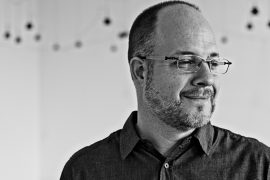Niloo Paydar is the Curator of Textiles and Fashion Arts at the Indianapolis Museum of Art (IMA). She is responsible for maintaining the museum’s collection, along with adding fashion and textile pieces from around the world. Niloo also organizes the IMA’s fashion and textile exhibitions that are available to the public.
You studied at Syracuse University in New York. Why did you decide to move to Indianapolis?
My husband took a job at IUPUI. We have lived here for more than thirty years – longer than anywhere else – so we have roots here since my two children were born here. We’re technically Hoosiers.
What is your textile background?
I studied surface pattern design at Syracuse University. This included not only fabric design, but other areas such as upholstery design and design for fashion. I went on the get an MFA in fibers from Syracuse, and then did post-graduate work in Museum Studies for two years.
How did you get your position at the IMA?
I started working here as a volunteer, even though I had a Masters degree and had completed post-graduate work. I had the background and knew I wanted to get into a museum, so I basically worked my way up.
How long have you been at the IMA?
I have been here for 29 ½ years.
What are your main responsibilities?
I’m in charge of the textile and costume collections. We have about 7,800 pieces from Asia, Africa, fashion and textiles from Europe, and we also have American fashion, quilts, and coverlet collections. Overall, it’s a very comprehensive and encyclopedic collection.
How many exhibitions have you assembled during your career at the IMA?
About 35 exhibitions, and mostly drawn from the IMA’s permanent collection.
What are you currently adding to the collection?
Right now I’m concentrating on acquiring Japanese fashion, such as Issey Miyake and Comme des Garcons. I just acquired three Miyake dresses through an auction in London.
Why Japanese fashion?
Japanese designs are very vanguard in regards to their approach to fashion and the female body, and since their emergence in the 1980’s, they have greatly influenced the conventions of Western clothing. I plan to do a Japanese fashion exhibition in 2018.
How has the local fashion scene changed since you have lived in Indianapolis?
It has changed a lot in the past ten or so years. There is a lot more interest in following the styles and trends, there are more bloggers, and people are a lot more serious about fashion. The fact that IU has a fashion design program shows that there is now more interest and demand.
How is fashion different when working in a museum?
For us, it’s not about trends, but more about styles that are ground-breaking and long-lasting. At a museum, we want to collect designers who have had tremendous influence on the fashion world.
What are your favorite local, national, and international designers?
Halston, who is from Indiana, is considered a master in terms of cut and construction. I have a lot of admiration for his designs. There have been influential American women designers. Claire McCardell was quite important in her time, along with Bonnie Cashin. Internationally, I like Dior and Chanel. And again, I admire the works of Issey Miyake and Comme des Garcons.
What are some events hosted by the Fashion Arts Society?
Hats Off! is an annual Fashion Arts Society event and it’s a big fundraiser for us. It includes a lecture, luncheon and other activities. This year, our speaker lectured about American quilts and their importance in American history and culture, and also discussed the importance of Marie Webster’s quilts.
Who was Marie Webster?
She lived in Marion, Indiana at the turn of the twentieth century and made her first quilt at the age of fifty. We’ll be celebrating her achievements this year in conjunction with Indiana’s Bicentennial celebrations. Her quilts were featured in Ladies’ Home Journal in 1911 and 1912, she wrote a book in 1915, lectured, and started a mail order business in 1921. She was a scholar, a quilt designer and an entrepreneur. I’m very passionate about her. She achieved so much during a time period when women couldn’t even vote.
What advice do you have for someone who is interested in textiles or a career in fashion?
You have to go to a school that has good resources, including bringing in speakers and fashion designers from all over in order to expose students to designs and trends that are applicable to the industry. That’s the first step. If you can go to graduate school, even better. It can be in Indiana. IU now has a fashion design program which is great, and so does the Art Institute. Try to do internships, even if they are for no or low pay. Study at a design studio to gain more experience. If possible, move to the east coast for some time, preferably New York City because that’s the center of fashion.
How do you use your role at the IMA to educate others?
Museums are collection based teaching institutions. Since I have been here, in every exhibition I try to teach people about textiles and to help them understand why textiles are so important in many cultures. It’s a lot less challenging now, since people have a better understanding of this art form than before when it was relegated to being a “craft.”



